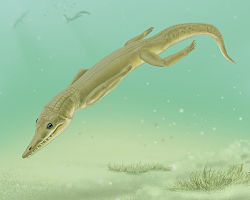Paleobiota
Invertebrates
- Ammonites: Clionitites sp., [3] Detoniceras sp., [3] Haoceras xingyiense , [3] [4] Parasturia sp., [3] Protrachyceras sp., [1] Ptychites sp., [3] Sinomeginoceras (S. wangi, S. xingyiense), [3] Trachyceras sp., [3] [4] Xenoprotrachyceras cf. primum, [3] Yangites densicostatus , [3]
- Bivalves: Daonella sp. [1]
- Conodonts: Gladigondolella malayensis , [4] [5] Metapolygnathus / Paragondolella / Quadralella (Q. aff. acuminatus, P. foliata, P. inclinata, Q. intermedius, Q. langdaiensis, P. maantangensis, P. navicula, M. nodosus, M. parafoliata, Q. aff. praelindae, P. polygnathiformis, Q. shijiangjunensis, Q. tadpole,Q. uniformis, Q. wanlanensis, Q. aff. wayaoensis, Q. yongueensis, Q. aff. zonneveldi) [1] [4] [5]
- Crinoids: Traumatocrinus hsui [1]
- Crustaceans ("shrimps"): Schimperella acanthocercus (Lophogastrida) [6] [1]
Fish
- Acrolepidae indet. [1]
- Archaesemionotus sp. [1]
- aff. Arctacanthus sp. (Chimaeriformes?) [7]
- Asialepidotus shingyiensis (Ionoscopiformes) [1] [8]
- Birgeria liui [1] [9]
- Caturidae indet. [1]
- Eosemionotus sp. [1]
- Favusodus orientalis (Euselachii) [7]
- Fuyuanichthys wangi (Ginglymodi) [10]
- Fuyuanperleidus dengi [1]
- Guizhouamia bellula [1]
- Guizhoubrachysomus minor [1]
- Guizhoucoelacanthus guanlingensis [1]
- Guizhouniscus microlepidus [1]
- Habroichthys sp. [1]
- Keichouodus nimaiguensis (Euselachii) [7]
- Luganoia fortuna (Luganoiidae) [11]
- Malingichthys (M. nimaiguensis, M. wanfendlinensis; Pholidophoridae) [12]
- Marcopoloichthys sp. [1]
- Peltopleurus (P. orientalis, P. tyrannos) [1] [13]
- Peripeltopleurus sp. [1] (Wushaichthyidae) [14]
- Pholidophoridae indet. [1]
- Potanichthys xingyiensis (Thoracopteridae) [15] [1]
- Rosaodus xingyiensis (Elasmobranchii) [7]
- Saurichthys sp. [1]
- Sinoeugnathus kueichowensis [1]
- Wushaichthys exquisitus [16] (Wushaichthyidae) [14]
- Xingyia gracilis [1]
Reptiles
| Reptiles of the Zhuganpo Formation | ||||
|---|---|---|---|---|
| Genus | Species | Notes | Images | |
| Anshunsaurus | A. huangnihensis [17] | An askeptosauroid thalattosaur [18] |   | |
| A. wushaensis [19] | An askeptosauroid thalattosaur [20] | |||
| Brevicaudosaurus | B. jiyangshanensis | A small nothosaur with an unusually short torso and tail [21] | ||
| Diandongosuchus [22] | D. fuyuanensis | A semiaquatic archosauriform, interpreted as a basal phytosaur [23] | ||
| Dingxiaosaurus | D. luyinensis | A pistosauroid of uncertain validity. [24] Previously believed to have been from the Yangliujing Formation. [1] | ||
| Fuyuansaurus [25] | F. acutirostris | A "protorosaur" archosauromorph, [25] possibly a tanystropheid [26] [27] | ||
| Glyphoderma [28] | G. kangi | A placochelyid placodont | ||
| Guizhouichthyosaurus | G. sp. [2] [29] | A large predatory merriamosaurian ichthyosaur | ||
| Keichousaurus | K. hui | A keichousaurid pachypleurosaur [30] [31] | ||
| Lariosaurus | L. xingyiensis | A small nothosaur [32] [33] | ||
| Litorosuchus [34] | L. somnii | A semiaquatic archosauriform related to Vancleavea campi | ||
| Macrocnemus | M. fuyuanensis | A small basal tanystropheid [35] | ||
| Nothosaurus | N. youngi | A large nothosaur [36] | ||
| Qianichthyosaurus | Q. xingyiensis [37] | A small toretocnemid ichthyosaur [2] | ||
| Qianxisaurus [38] | Q. chajiangensis | A basal eosauropterygian, possibly related to pachypleurosaurs or nothosaurs | ||
| Tanystropheus | T. cf. hydroides [39] | A large tanystropheid, previously classified as T. cf. longobardicus [40] | ||
| T. sp. | A small tanystropheid, previously classified as T. cf. longobardicus [40] | |||
| Wangosaurus [41] | W. brevirostris | A pistosauroid | ||
| Xinpusaurus | X. xingyiensis [42] | A thalattosauroid thalattosaur [29] | ||
| Yunguisaurus | Y. liae | A pistosauroid [43] [24] | ||
